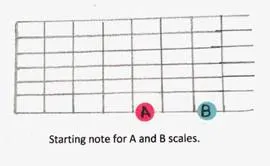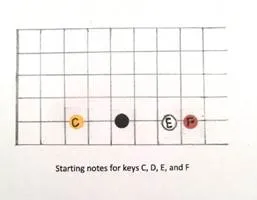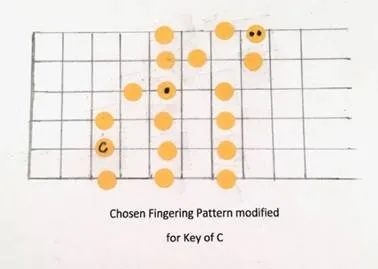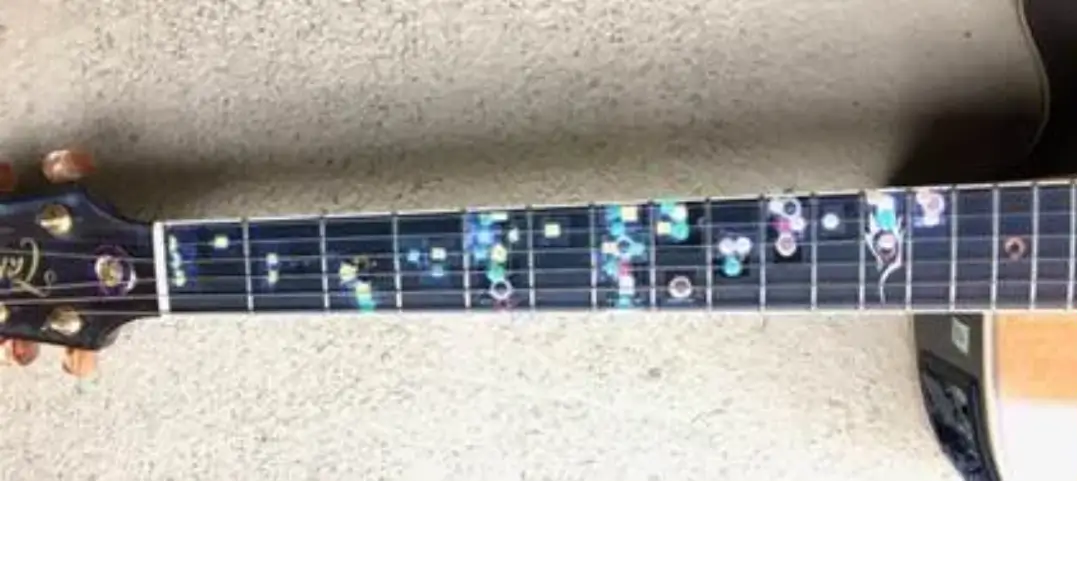PLAYING SONGS IN THE KEY OF G
There are two basic problems with playing the melody of a song: (1) finding the first note, and (2) finding each note thereafter. The procedure for (1) and (2) are quite different.
To find the first note, one plays the scale of the musical key you want to use. You do this by playing the root (lowest) note (#1) of the scale. That note would be the green marker with G written on it. Then play the numbers up the scale until you reach the green marker with one black dot on it. Then hum the start of the song and play the G scale until you know the proper note to start the song. Or, if you know the G chord, you can play it and hum to find the correct note to start the song. For example, use the song "Georgia On My Mind". You will find the song starts on note #3. If you are making a book of the words of the songs you play, write after the title of "Georgia" G3, meaning the key that fits your vocal range is G and the song starts on the #3 note. That way you will never again have to decide the key or look for the first note of "Georgia".
To play the second note and all subsequent notes, one uses my method of playing lead guitar. There are 126 notes on the guitar fretboard to choose from to find the second note of the song. You have just a fraction of a second to find it. You need a method - hopefully mine. When you choose the musical key, let's say G, the only notes you will use in the song are the green ones. Most people instinctively know whether the next note is up or down the scale, whether the note is one or more notes up or down, and know if the melody jumps an octave. At that point you have reduced the possible notes from 126 down to three or four. Of course, it is the long jumps between the notes, like from note 2 to 5 that are more difficult to find. (If you have the words written of the song you are practicing, you can write the number above the word of the long jumps to remember it jumps to the 5th note.) Here is when experimentation and practice teach you. Let's take, for example, the song "Jesus Loves Me". I learned that song probably at age three, have never seen written music for it, and have no notion what notes I am singing. I just know the melody line. With this method, with almost no practice, you will be able to slowly play such songs correctly the first time from your memory formed, maybe 30 or 50 years ago.
Playing of G scale and “Jesus Loves Me”.
Try simple songs like “Mary Had a Little Lamb” and find the next note. Try “America”. It does not take long to graduate to a song like “In Other Words (Fly Me to the Moon)” . (I sincerely apologize for the playing mistakes made by the guitarist in this video. I wanted a professional guitarist to introduce this easy method to the world. But, as of this writing, I am the only person who has heard of this method. The method is so easy that this video was shot three months after devising the method.)
"On the solo break of this song, the Color-Coded method was used on the guitar."
Fly Me to the Moon
ADDING MARKERS TO THE FRETBOARD FOR THE OTHER KEYS
Let's now add markers to the fretboard for the key of A (red) and B (blue). The same fingering pattern of G is used for the keys of A and B, which also have their lowest dot on the low E string. (Refer to the Chosen Fingering Pattern for the key of G above.) Start the pattern for A on the A note and the pattern for B on the B note. (See the illustration on this page.) After some more practice with that pattern, you can place the markers on the fretboard for the keys of C, D, E, and F, which start the scale on the A string using the pattern on the far right of this page).
The fingering pattern we are now going to mark on the A string is a modification of the pattern we used when starting on the low E string. My written explanation below is for your understanding only. You do not have to remember this explanation because this new pattern will be plastered on your fretboard in living color. The explanation: this modification of the basic fingering pattern starts on the A string, which shifts the whole fingering pattern up one string in placement, so it looks like the yellow dotted finger pattern for the key of C above. Another change is that the three fingering dots on the B string (next to the highest pitched string) have been shifted one fret to the right. (This shift is necessary because of the tuning of the guitar. The guitar tuning was originally set up so that there were 4 half-step notes between each of the adjacent strings, except between the G and the B strings. Between those strings, there are only three half notes. Because of this tuning change, we have to use this modification. You will also note that since the three notes were removed from the low E string, we will add three evenly spaced dots so you can play that string if you want to. These modifications and more are what some lead guitar courses ask you to memorize. These three modifications of the fingering pattern are marked on the fretboard, so you don't have to memorize them. (I do not place markers on the guitar when the finger positions are three notes spaced evenly on the same string (see the lower three strings on the diagram of Chosen Fingering Pattern used for the key of C on the right of this page because three evenly spaced dots are very easy to remember.)
(I placed the less frequently used keys of B, E, and F scales far up the fretboard to get their markers away from the markers of the more frequently used keys of A, C, D, and G, which were placed on the lower fretboard.)
The chosen fingering pattern or its modifications are used for each of the seven major musical keys. Here is how you play in a key that is in between the notes of major keys, such as B flat, E flat, or C sharp. For example, to play in B flat, you use the key of B (blue) markers and place your fingers one fret to the left of the marked positions, which lowers the pitch by half a note. To play in C sharp, you use the key of C (yellow) markers and place your fingers one fret to the right of the marked positions. To do this may sound nearly impossible, but it does work because the markers of the major keys are marked on the fretboard. About the only time, you might be expected to play in a half-tone key would be in a jazz band or orchestra. They frequently use the key of B flat to accommodate the trumpets or may use the key of E flat to accommodate the saxophones. Another use is occasionally; I will start a song in the key of B flat, play a little, and then modulate to the key of C as in the video of "Have I Told You Lately That I Love You." Both the piano and guitar are played by ear. This song was played three months after devising this method. On the first part of the guitar solo, I use the Color-Coded lead method. On the second part of the guitar solo, I use the Duo Method explained below. This method uses only the top two strings of the guitar in harmony.



Have I Told You Lately That I Love You
You should play the fingering pattern in every key with only the designated fingers I suggest so that you will develop muscle memory and eventually play without thinking about what fingers you are using. Use your little finger where it is the designated finger because with it, you will play runs faster, and there is less horizontal movement of the hand than when substituting your ring finger for the little finger. Your muscle memory from playing in the key of G transfers automatically and completely to the other keys.
If your fretboard is blond, the white marker for the key of E will not stand out, or it may be confused with the manufacturer's pearl-inlayed dots on the fretboard. You can cut a marker from a black paper of a round marker that is slightly larger than the white marker, so it forms a black ring around the white marker. A black marker on a dark fretboard will not stand out. You can use white paper to form a marker background.
The minimum marking on the fretboard of a musical key is a marker on the root note with the letter of the key on it, a marker for the one-octave note with one black dot on it, and a marker for the second-octave root note with two dots on it. I have on my guitar the keys of A, B, D, and E marked that way. The maximum marking of a key on the fretboard is to mark every note on the scale. I set up my fretboard that way on my favorite keys of C, G, and F. ( I repeat that I do not mark the three evenly spaced notes on the same line because they are easily remembered.)

My guitar is set up to play in all keys. It is customized with a maximum marking of my most used keys of C, G, and F, and minimal marking of my least used keys of A, B, D., and E.